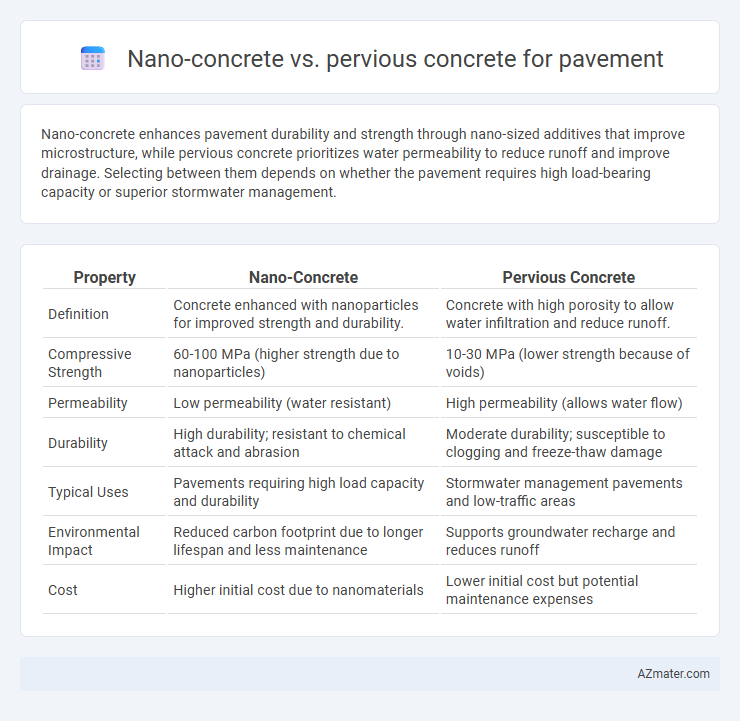Nano-concrete enhances pavement durability and strength through nano-sized additives that improve microstructure, while pervious concrete prioritizes water permeability to reduce runoff and improve drainage. Selecting between them depends on whether the pavement requires high load-bearing capacity or superior stormwater management.
Table of Comparison
| Property | Nano-Concrete | Pervious Concrete |
|---|---|---|
| Definition | Concrete enhanced with nanoparticles for improved strength and durability. | Concrete with high porosity to allow water infiltration and reduce runoff. |
| Compressive Strength | 60-100 MPa (higher strength due to nanoparticles) | 10-30 MPa (lower strength because of voids) |
| Permeability | Low permeability (water resistant) | High permeability (allows water flow) |
| Durability | High durability; resistant to chemical attack and abrasion | Moderate durability; susceptible to clogging and freeze-thaw damage |
| Typical Uses | Pavements requiring high load capacity and durability | Stormwater management pavements and low-traffic areas |
| Environmental Impact | Reduced carbon footprint due to longer lifespan and less maintenance | Supports groundwater recharge and reduces runoff |
| Cost | Higher initial cost due to nanomaterials | Lower initial cost but potential maintenance expenses |
Introduction to Nano-Concrete and Pervious Concrete
Nano-concrete incorporates nanoparticles such as nano-silica or nano-titanium dioxide to enhance the mechanical strength, durability, and impermeability of traditional concrete, making it highly suitable for high-performance pavement applications. Pervious concrete features a porous structure with interconnected voids, allowing water to infiltrate through the pavement surface, reducing runoff and promoting groundwater recharge in urban environments. Both materials offer unique benefits for sustainable pavement design, with nano-concrete emphasizing strength and longevity, while pervious concrete prioritizes permeability and environmental management.
Material Composition and Properties
Nano-concrete incorporates nanoparticles such as nano-silica and nano-titanium dioxide into traditional concrete, enhancing strength, durability, and resistance to environmental degradation through improved hydration and microstructural densification. Pervious concrete is characterized by high porosity due to its low cement paste content and the use of coarse aggregates, allowing water permeability which reduces surface runoff and promotes groundwater recharge but generally exhibits lower compressive strength compared to conventional concrete. The material composition of nano-concrete targets performance enhancement at the molecular level, while pervious concrete prioritizes porosity and permeability for sustainable pavement applications.
Strength and Durability Comparison
Nano-concrete exhibits significantly higher compressive strength and enhanced durability due to the incorporation of nano-sized particles that improve cement hydration and reduce micro-cracks. Pervious concrete offers excellent permeability and water drainage but generally demonstrates lower compressive strength and reduced long-term durability under heavy traffic loads. The choice between nano-concrete and pervious concrete for pavement depends heavily on the balance required between mechanical strength and permeability performance.
Permeability and Water Management
Nano-concrete features ultra-fine particles that reduce porosity, resulting in low permeability and limited water infiltration, which can lead to surface runoff issues in pavement applications. Pervious concrete, designed with a porous structure, enables high permeability, allowing stormwater to pass through the pavement, promoting groundwater recharge and effective water management. In urban infrastructure, pervious concrete significantly mitigates flooding risks and improves water quality by filtering pollutants, whereas nano-concrete prioritizes strength and durability over permeability.
Environmental Impact and Sustainability
Nano-concrete enhances pavement durability and reduces maintenance frequency by incorporating nanoscale additives that improve strength and reduce permeability, leading to lower lifecycle carbon emissions. Pervious concrete facilitates stormwater infiltration, mitigating urban runoff and improving groundwater recharge, but may require more frequent upkeep due to reduced mechanical strength. Balancing these materials involves assessing trade-offs between environmental benefits such as reduced urban flooding with pervious concrete and enhanced longevity and reduced resource consumption with nano-concrete.
Cost Analysis and Economic Viability
Nano-concrete offers superior durability and reduced maintenance costs compared to pervious concrete, but its initial material costs are significantly higher due to advanced nanomaterials and production complexity. Pervious concrete provides cost-effective stormwater management and lower installation expenses, making it economically viable for large-scale pavement projects in regions with ample rainfall. Evaluating life-cycle costing reveals that nano-concrete's long-term savings on repairs can offset upfront investment, while pervious concrete remains favorable for projects prioritizing immediate budget constraints and environmental benefits.
Applications in Pavement Construction
Nano-concrete enhances pavement durability and strength by integrating nanoparticles that improve hydration and reduce micro-cracking, making it ideal for high-traffic urban roads and heavy-load industrial pavements. Pervious concrete optimizes stormwater management through its porous structure, enabling rapid water infiltration, which is advantageous for parking lots, sidewalks, and low-speed roadways requiring effective drainage and reduced runoff. Both materials serve distinct functional purposes in pavement construction, with nano-concrete primarily targeting structural integrity and pervious concrete emphasizing environmental sustainability and water management.
Maintenance and Lifespan Considerations
Nano-concrete exhibits enhanced durability and reduced permeability compared to pervious concrete, leading to lower maintenance requirements and extended lifespan for pavement applications. Pervious concrete, while effective for stormwater management, typically demands more frequent maintenance to prevent clogging and maintain permeability, which can reduce its service life. Optimizing nano-concrete formulations significantly improves resistance to environmental degradation, thereby extending pavement longevity in high-traffic areas.
Performance Under Different Climatic Conditions
Nano-concrete exhibits superior durability and reduced permeability, enhancing pavement resistance to freeze-thaw cycles and minimizing micro-cracking in cold climates. Pervious concrete improves water drainage and reduces surface runoff, making it ideal for hot and rainy regions but may suffer from reduced strength and clogging in freeze-thaw environments. Both materials offer climate-adaptive benefits, with nano-concrete suited for harsh winters and pervious concrete optimized for managing stormwater in temperate to tropical climates.
Future Trends and Innovations in Concrete Pavements
Nano-concrete incorporates nanoparticles such as nano-silica to enhance mechanical strength, durability, and self-healing properties, showing promise for longer-lasting pavements. Pervious concrete innovations focus on optimizing porosity and permeability to improve water drainage while maintaining structural integrity, addressing urban runoff and heat island effects. Future trends emphasize integrating smart materials and nanotechnology to develop pavements with real-time monitoring capabilities and enhanced sustainability.

Infographic: Nano-concrete vs Pervious concrete for Pavement
 azmater.com
azmater.com